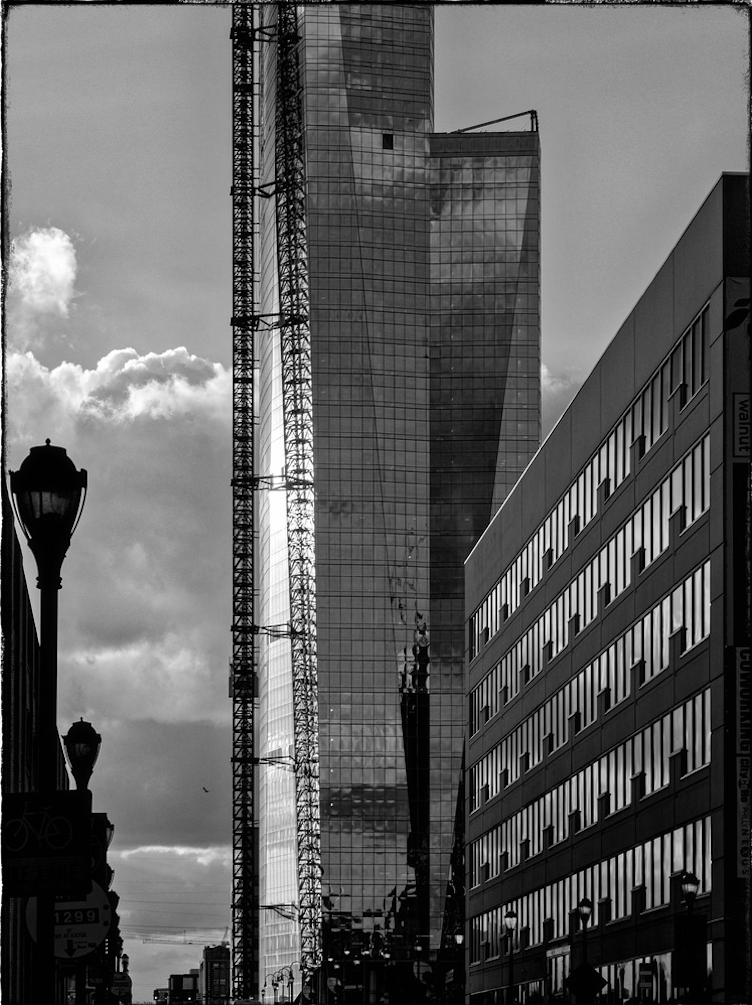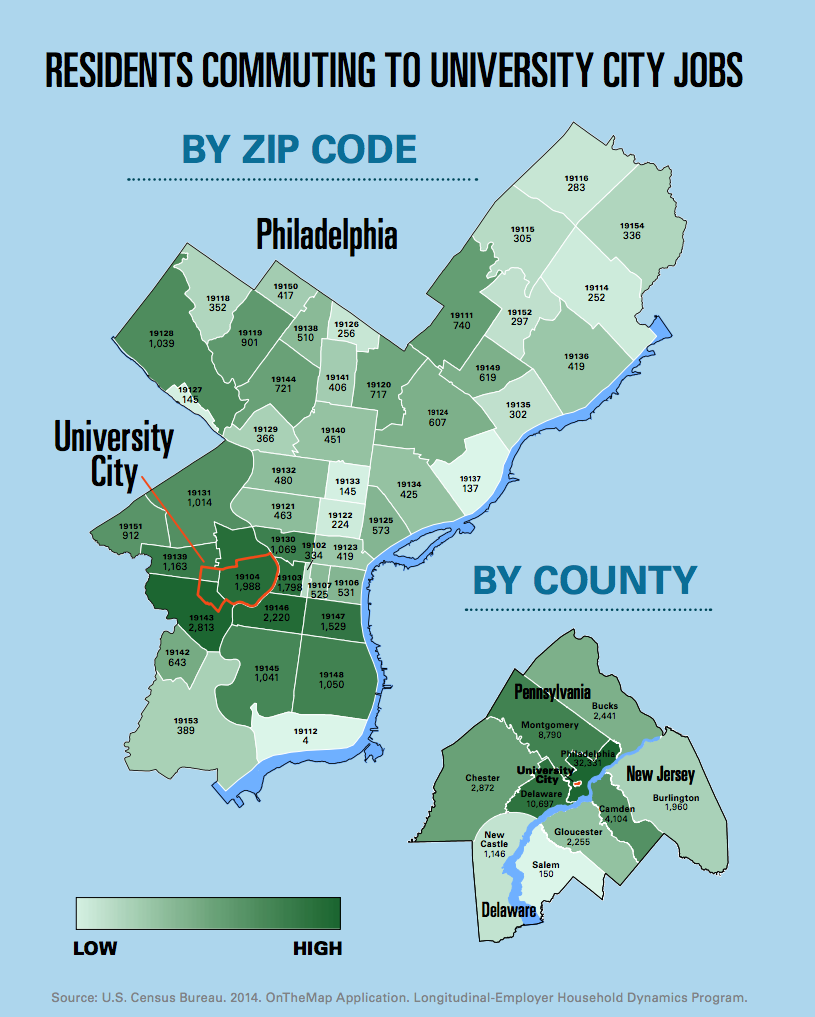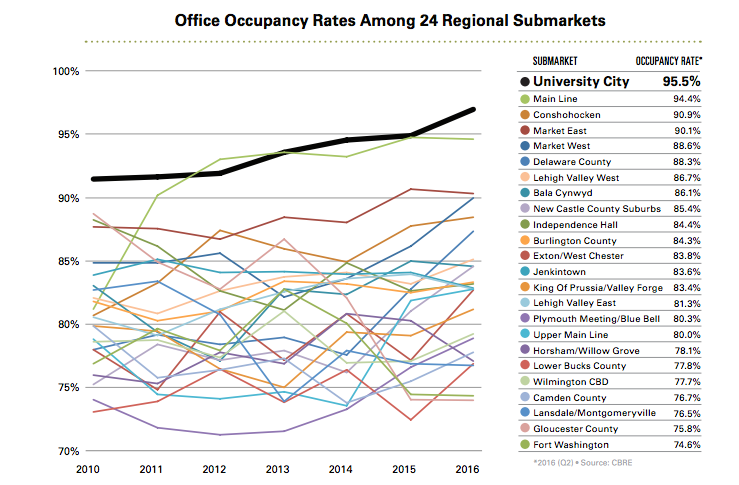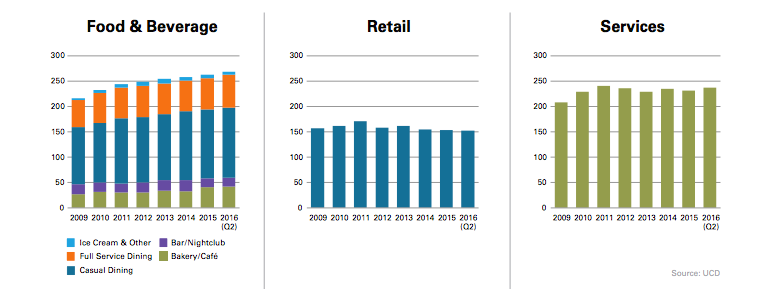Takeaways from the State of University City, 2016

The University City District wants you to know that Philadelphia is about to have two central business districts—if it doesn’t already.
This year “State of University City” report is a data-filled, graphics-heavy ode to the ever-growing tech, medical, and education cluster on the western banks of the Schuylkill.
Much of the report is focused on the impressive job numbers, which have grown to almost 77,000 from 75,000 last year. Another focus point is the five gargantuan real estate projects expected to transform University City, including ambitious proposals like uCity Square and the Schuylkill Yards, which are expected to expand the availability of new lab, office, and residential space by millions of square feet in the coming years.
While the vision of another skyline rising from banks of the Schuylkill certainly makes for a fun thought experiment, here are a few more immediate takeaways on the state of University City District as we know it right now:
What is the job mix in Univeristy City and where do workers commute from?

Source: State of University City 2016 (click to enlarge)
Did you know that 11 percent of Philadelphia’s jobs are based in University City, or that the IRS employs more people in University City than Drexel University does?
In University City 77 percent of jobs are in healthcare and education. The second largest cluster, “entertainment, hospitality, and retail,” is 8 percent of the total.
Wages in University City seem to be substantially higher than in the city as a whole. In University City almost 70 percent of jobs pay over $40,000 a year. In the rest of Philadelphia, less than half do. Although the report doesn’t go into this in great detail, there are a fair number of stable working class jobs in security, maintenance, and food service although only a few shops enjoy union protections. The West Philadelphia Skills Initiative, a job training program highlighted in the report, tries to connect low-income West Philadelphians with work in the district. Not mentioned in the report: the demand is overwhelmingly high. In 2015, the initiative reported that 3,500 applicants contested for 120 seats in the program.
The jobs in University City are split almost evenly between Philadelphians (32,331) and residents of the nine suburban municipalities (34,415). Of the suburban counties Delaware County supplies the most workers, with 10,698. Montgomery County is in second place with 8,790, then Camden County with 4,104. No other county cracks 3,000.
Within the city, the zip code that provide the most workers are 19143, which mostly lies within University City District and contains neighborhoods like Spruce Hill, Cedar Park, and Garden Court. Next is 19146 in Center City, but no other zip code provides over 2,000 workers. Most of those that provide over 1,000 workers are located in South Philadelphia, Center City, or other parts of West Philadelphia—along with Roxborough.
Office occupancy ranks well regionally

Source: State of University City 2016 (click to enlarge)
Although University City District has been adding office space at an impressive clip, including the newly erected FMC Tower, it appears to have the highest office occupancy rate in the Philadelphia metropolitan region, at 95.5 percent, followed closely by the Main Line at 94.4 percent. The rest of the top five tightest office markets are rounded out by Conshohocken (90.9%), Market East (90.1%), and Market West (88.6%), an order that speaks to the nascent emergence of Center City east of City Hall as a strong office market.
The fact that many suburban areas have far higher office vacancy rates—83.4 percent at high end King of Prussia/Valley Forge and 74.6 percent in the office parks of Fort Lee–is potentially a good sign for the job ally sprawl that has long haunted the Philadelphia region. In 2013 the Brookings Institute, found that 64 percent of regional jobs were 10 to 35 miles outside the central city. Perhaps it’ll be lower next time.
Where do all the students go?
University City contains four colleges and universities, which have 44,000 undergraduate and graduate students combined. 25,000 of those students reside within University City District, a 17 percent increase since 2000.
There are two stories buried in those number. First, the grad student population surged dramatically since 2000. More of the people getting advanced degrees at the University of Pennsylvania and Drexel are deciding to actually live in an adjoining residential areas. In many of the surrounding neighborhoods, which include collections of Victorian houses, old twins and townhouses have been carved into apartment to accommodate this boom—despite pushback from some neighborhood groups.
But grad students, generally speaking, are easier for other people to live among than undergraduates. The University City District report shows that roughly half of Penn’s undergraduates live on campus, while only 3,471 of Drexel’s 16,464 undergraduates do. Penn is the only school in the area with anything close to parity among on and off campus housing of its undergraduate population.
A bunch of new restaurants
The University City District also reports an explosion in dining options, up 24 percent since 2009. Food uses make up 44 percent of the retail offerings in the district, outstripping the next three uses combined (apparel, books and music, and pharmacy).
It’s quantity, not quality, of offerings measured by UCD in terms of growth. University City might not yet be able to rival South Philadelphia or Center City as a hub of the city’s food culture.
The report names few restaurants, trumpeting just the presence of “renowned chef Jose Andres” and the new locations of Spread Bagelry and honeygrow.
There are, by the district’s count, 268 restaurants and bars in the 2.4 square miles of University City District. This is not surprising in a student and professional mecca. But the number of bars and nightclubs in the area is actually on the decline, with only 17 of these youth-magnet businesses in the district’s boundaries. The only type of restaurant use that is less prevalent by UCD’s count is ice cream shops, of which there are six.

WHYY is your source for fact-based, in-depth journalism and information. As a nonprofit organization, we rely on financial support from readers like you. Please give today.






